Apple iPad mini with Retina Display: Reviewed
by Anand Lal Shimpi on November 16, 2013 8:00 AM ESTThe SoC
The iPad mini with Retina Display rounds out the three platforms that use Apple’s A7 SoC. Although both the iPad Air and iPhone 5S use the A7, the mini’s implementation is closer in nature to the iPhone. The iPad mini’s SoC has always used the same package-on-package (PoP) assembly as the iPhone, with DRAM stacked on top of the SoC itself (1GB in this case). The benefit is obviously a reduction in board area, the downsides have to do with cost and thermals. That’s the first similarity between the mini’s A7 and the iPhone’s A7.
The second is one of frequencies. While the iPad Air’s A7 runs its two Cyclone CPU cores at up to 1.4GHz, the SoC in the iPad mini and the iPhone 5S runs at up to 1.3GHz. That might sound like a minor difference, but it’s far more pronounced when you look at what happens to frequency when you’re running heavy workloads.
Once again I turn to a fairly heavy CPU workload to plot performance over time. This is a multithreaded workload, slightly modified from what we used in the iPad Air review, designed to make the CPU cores consume max power. The scale is linear and the workload is the same across all devices, so what you’re effectively looking at is a graph of thermally bound CPU performance over time across all three A7 implementations:
Being the largest device (and the only device with a metal heat spreader and no DRAM stacked on top), the iPad Air obviously maintains the highest frequencies for the duration of the test. The iPhone 5S, with a significant reduction in internal volume (and a PoP SoC) reduces its CPU frequencies early on in order to keep skin temperature down and properly manage thermals. The iPad mini with Retina Display falls between the two, with its performance curve more closely following that of the iPhone 5S.
Although the mini has a similar max operating frequency to the iPhone 5S, it is a faster device thanks to it being less thermally constrained. Similarly, the iPad Air can be much faster than its clock speed would otherwise imply. If you’re wondering why Apple has been so focused on building its own SoCs and CPU architectures, this is the reason why. There’s a fixed amount of power you can dissipate in the form of heat in these mobile devices while still maintaining a good user experience. Performance per watt is the gating metric for success in mobile, and shipping high IPC/low frequency dual-core SoCs at 32/28nm is the best optimization available to a company like Apple today.
As you’d expect, our browser based CPU tests show the mini’s A7 performing in between the iPhone 5S and iPad Air. None of these tests are anywhere near as stressful as our thermal test from above, so we don’t see exaggerated differences in performance between the platforms. For most, I suspect you won’t notice a huge performance difference between the mini and Air. Those who are heavier users (e.g. audio mixing, 3D gaming, etc…), there will be a performance difference between the two iPads.
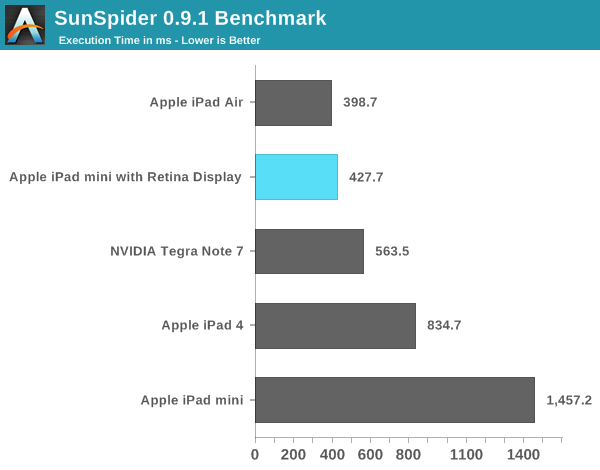

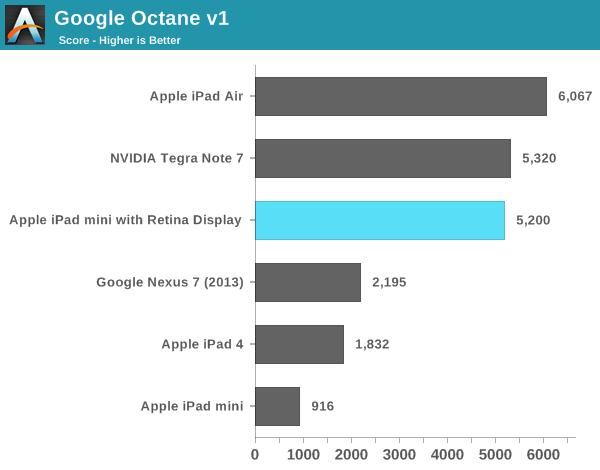
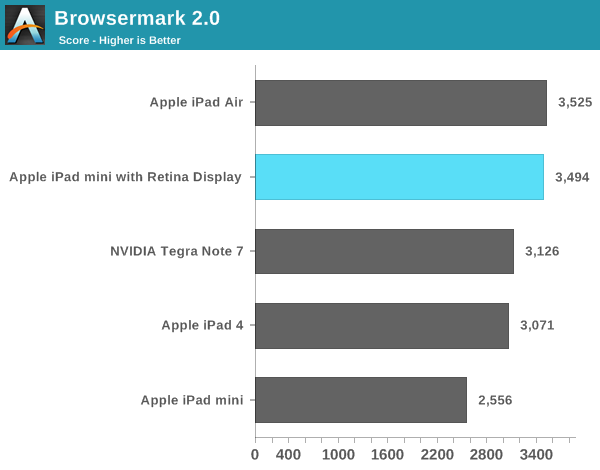
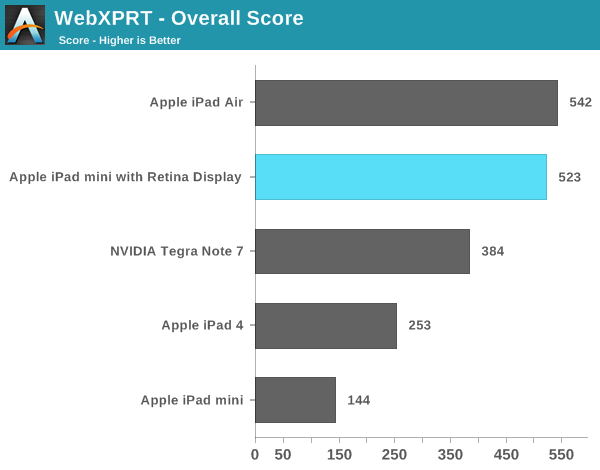
Compared to the first generation iPad mini, the new model is in a completely different performance league. Keep in mind the first mini used Apple’s A5 SoC based on an ARM Cortex A9. That’s the same single threaded performance as what’s in an iPhone 4S, and under iOS 7 it’s clearly running into some performance limits. The new mini with Retina Display however is a completely different animal. It’s fast.
Even comparing to the 4th generation iPad, the new mini is noticeably quicker.
Memory Bandwidth
Looking at the iPad mini’s memory bandwidth curve, we see it tracks very closely with that of the iPhone 5S. This is a slightly modified version of our previous bandwidth test, and you can see peak usable memory bandwidth (from the CPU’s perspective) of around 10GB/s. The ~12GB/s area right before you get out to main memory is bandwidth to the A7’s 4MB system-wide cache that sits after the shared L2 and the memory controller. This cache appears to service CPU, GPU and ISP requests at least.
GPU Performance
I believe the A7’s PowerVR G6430 GPU runs at around 450MHz. This frequency appears unchanged across all three A7 implementations. Once again, the big difference is how much thermal headroom exists in the platform which has an impact on overall performance.
Kishonti’s low level GPU performance tests back up my assertion that GPU frequency is fixed across all A7s. The iPad mini with Retina Display delivers equal performance to the iPad Air. The bigger news here is that nearly all of the GPU bound 3D tests seems to peg the mini and Air as equals. These are some pretty intense tests, but it looks like on the GPU side there’s no significant throttling when running at full tilt.
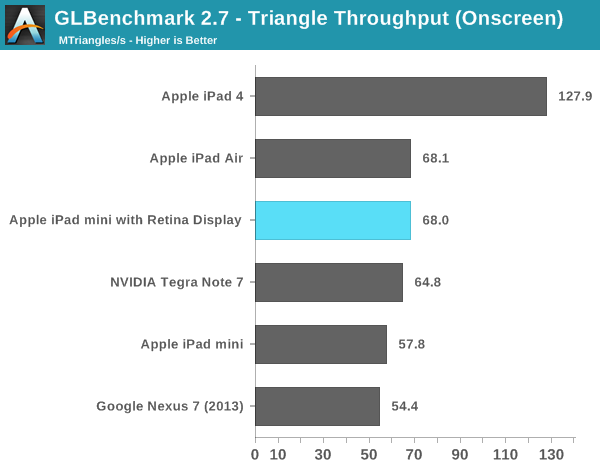

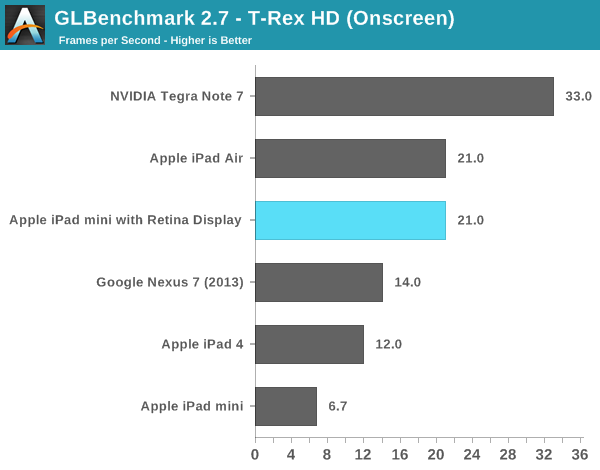

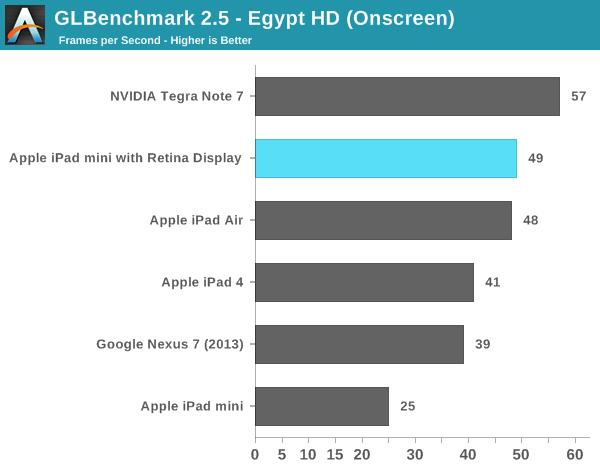
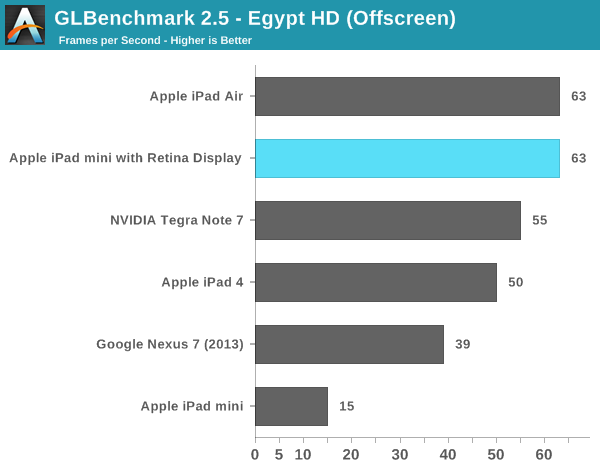
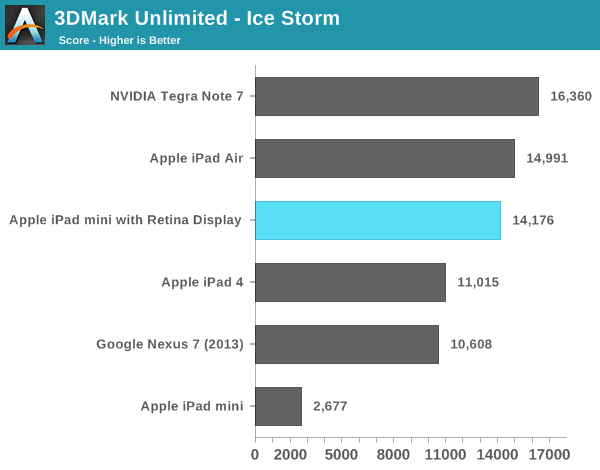
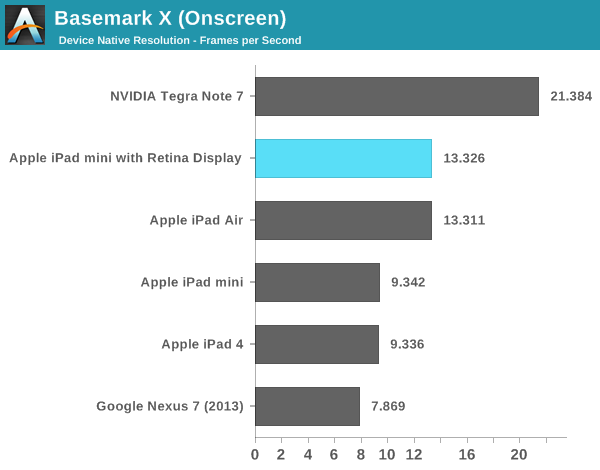
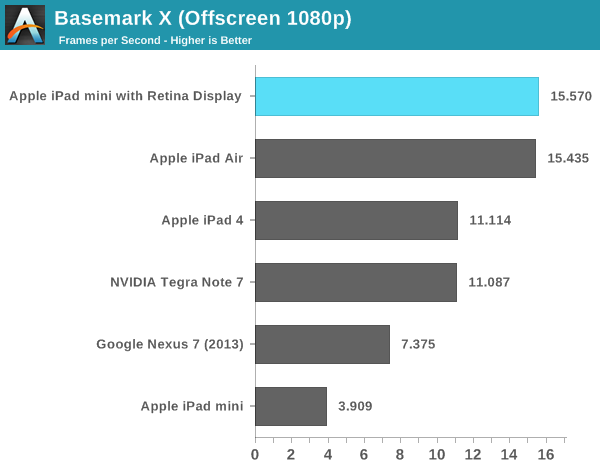
As I mentioned in our iPad Air review, despite having less peak theoretical memory bandwidth than the A5X/A6X, the A7 in the iPad mini never seems to regress in performance compared to even the iPad 4. Across the board the mini appears to be faster, more responsive and have more performance on tap than any prior iPad (big or small). The comparison to the original iPad mini is of course night and day. Even looking at lighter tests like the old GLBench Egypt HD benchmark, the iPad mini with Retina Display manages to be nearly twice as fast as the original mini - all while rendering 4x the number of pixels.


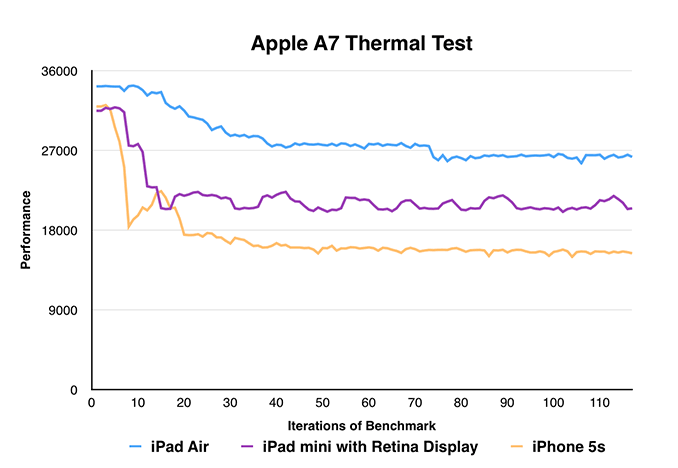
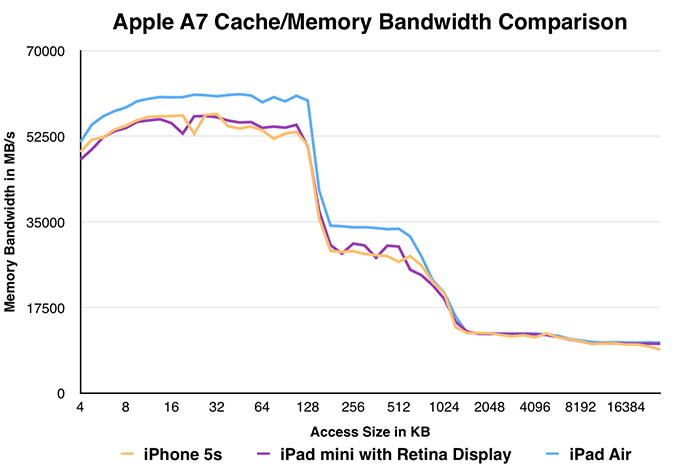








345 Comments
View All Comments
BPB - Saturday, November 16, 2013 - link
"The absolute quality of a product may have more importance to some than the quality/price ratio when comparing products that are all within one's budget. By your logic, why wouldn't one suggest an even cheaper tablet than the Nexus 7?"See my comment above. He called the Nexus "incredible" and "truly great". In my book that means really high quality. Show me a person who thinks that of the Hisense. I think comparing the Nexus 7 to the mini is comparing two high quality products. And one of them costs a lot less, at least for folks in my income bracket.
Please understand, I have no problem with folks saying Apple products are good, really good. And I don't deny they are. I can't because I don't use them. The point in my original post is that if it's an Apple review at this site, it will be glowing.
EnzoFX - Saturday, November 16, 2013 - link
Glowing sure, and rightly so. The N7 review was also glowing. Some people just like to whine no matter what. They like to come on here and lead us all down a pathetic back and forth. It surprises me the number of people who entertain comments like these. I would not normally, but after all these... Why bother? Why read Anandtech if you don't like the facts they present... I don't really care to hear an answer...p_giguere1 - Saturday, November 16, 2013 - link
Those "incredible" and "truly great" terms are relative to the competition and to our expectations, and quality level isn't as black and white as you make it sound.I'm sure that cheap Hisense tablet would have been considered high-quality if it had been released one year sooner. Just like the 2013 N7 probably won't be considered high-quality when you'll measure it against a 2014 N7, just like a 2012 N7 could hardy be called high-quality right now.
The 2013 N7 was released (and reviewed) at a time when there was no Retina iPad mini. When the standard to beat was the regular iPad mini which had a relatively low-res display and an old SoC despite its higher price tag. Had the 2013 N7 be released right now, I'm sure the general tone reviewers would have had would have been a little different, because people's expectations would also have been higher just because the market has already changed since then.
Anyway, why do selectively choose when the tone of reviewers matters? If Anand has a positive tone when reviewing the Nexus 7, that means it's an exceptional product that easily justifies its price tag compared to cheaper alternatives, yet when he does the same with the Retina iPad mini, it doesn't count and he's biased? What's the difference?
Puberticus - Saturday, November 16, 2013 - link
Well look at the bright side: we won't have to fret for long.Displays are already as good as the eyeball can see. So what's left making it thinner, lighter and last longer? Whatever.
Again IMHO, I think the iPad Air is pretty much the end of the line as far as added value goes. If I'm wrong, I'll be pleasantly surprised.
beggerking@yahoo.com - Monday, November 18, 2013 - link
well, Anand had positive ton about Mac Air, which STILL HAS NO RETINA NOR TOUCHSCREEN display...in the mean time, everything else mid end or up has at least 1080p... even a Dell Venue Pro for $600 has 1080p with touch screen...
angermeans - Sunday, November 17, 2013 - link
I've read all of your comments to this point. Your making it sound as if the Nexus 7 and iPad mini are on equal grounds and because of this people should choose cost every time. If you were right I would agree (such as they both ran the same software), but your not and not even close. I've got the 2013 N7 and the new iPad mini with retina display sitting right next to me. Last year I had both the 2012 N7 and iPad Mini original. In all your comments you forget one glaring fact and that is Eco system. Android tablets (even at their absolute best such as the N7) are no where even close to iOS. When people want a tablet they sent great tablet optimized apps and you don't get even close to tablet apps on the Nexus 7 (or other android tablets). The android tablet Eco system is so behind iOS that they don't even deserve to be in the same sentence together, but they often are. Yes, the N7 is a great value and has great hardware (although nowhere near apples tablets, but ill leave hardware out of this comment for now), but it is nothing more than a giant phone with giant oversized android apps. One will get a much better lifetime value with an iPad over an android tablet. This is why apple absolutely dominates the tablet market despite costing much more and their dominance is the reason companies like google have been forced to release low cost devices in the first place as they simply cannot even compete. This won't ever change no matter the hardware until the android app situation gets better and I just don't see it happening anytime soon. You can't even get an optimized twitter tablet app and when you finally do then samsung gobbles it up as an exclusive. This doesn't happen on iOS and the constant OS updates even make it better. My nexus 7 sadly has sat 90% of the time (despite being a great value) because of the reasons (among others such as constant lag on android platforms). Android tablets are nothing more than media consumption devices whereas iPads are so much more. No reason to be sore about it and the fact that Ananda gave a fair review while not pointing out the severe gap In the two Eco systems shows his non bias and straight review of the hardware.akdj - Sunday, November 17, 2013 - link
@Angermeans, so well and eloquently said. I own the Xoom, Note 2, and have had every iteration of iPad and iPhone (we have had a business for 22 years that has literally been transformed with the introduction of the iPad, it's 'Eco system' and the software available for productivity. We use them 60 hours a week in the field and they've replaced 70-80 pounds of gear we used for well over a decade and a half. I bought this year's Nex7 (I wasn't convinced, like Anand...that a retina or HiDPI screen would be included in this year's mini). Don't know why. I've been burned now twice...and while the Xoom still works fine for a few things (and as a 'Google' device was always up front to get updates), I can't get out of the Note contract fast enough (my daily driver is a 5s...my wife the iPhone 5). We bought it solely for the business and signing contracts and credit cards with Square. What a joke. We don't use it for either. In fact, for both contract signatures and credit card payments, the iPhone and iPad works faster and more efficientlyI can't tell you how pissed off it makes you after downloading an app from the Play store only to see....'Not optimized for your device/tablet'. This is a phone app. Works just fine on the s4. Not the Note. Not the Nex 7. While the 2013 Nexus 7 is an incredible value with a phenomenal display and pretty decent/swift performance (TouchWiz is the Devil's UI!)---other than for surfing, email, maps or watching a movie, I find it useless in comparison with the iPad. It's wild to see such devoted Android fans jump in, take the time to comment, and attempt to discredit one of...if not the top tier of technological review teams on Al Gore's interwebs. I LOVE tech. I give them both a try. But just as Windows reigned supreme for a pair of decades when it came to software choice, the same is now try for iOS and tablet 'optimized' applications and software. Replacing FLIGHT BAGS! For crying out loud....Jep charts, ops guides and plates....40-50 pound commercial (& redundant with both pilot and F/O) pilot flight bags....history, replaced by a 1.3 pound iPad 2 (maybe some have upgrade to retina?).
Doesn't matter WHAT you're into. There is 'an app for that'. In iOS. Not Android. Creative, photo/videography, writing, coding, gaming, productivity and 'office type suites', utilities and Topo maps....flight planning and GPS route following software, fuel calculators and guitar tuners, the list literally goes on forever! Jimi Hendrix? The Stones? Leonardo DaVinci in high resolution.....it's crazy the options that exist in iOS. And their intuitive nature.
Android tablet apps in the other hand....other than Facebook and World Series of poker, I'm lost. Oh yeah, Evernote works out alright as well as Dropbox. There's. That.
KoolAidMan1 - Sunday, November 17, 2013 - link
akdj - The other mobile ecosystems aren't anywhere close. I use WP8 but have an iPad for my tablet because its library is so much better than WinRT and Android.The Nexus 7 is cheap but it does so little compared to the iPad. It is a toy in comparison. The Kindle is even more limited on top of having lower quality hardware. The less said about WinRT the better...
RadarTheKat - Monday, November 18, 2013 - link
He also forgot screen size (iPad mini is larger) and resale value (which means the overall cost of the iPad mini is not so far off from the N7 as the retail price suggests).RadarTheKat - Monday, November 18, 2013 - link
And the whole cheaper can be better value falls apart with Apple products because of the high resale value based upon build quality and demand. So that iPad might actually, full cycle, cost no more than an initially cheaper competing tablet.